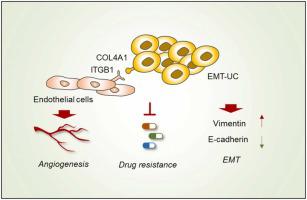当前位置:
X-MOL 学术
›
Drug Resist. Updat.
›
论文详情
Our official English website, www.x-mol.net, welcomes your
feedback! (Note: you will need to create a separate account there.)
A distinct subset of urothelial cells with enhanced EMT features promotes chemotherapy resistance and cancer recurrence by increasing COL4A1-ITGB1 mediated angiogenesis
Drug Resistance Updates ( IF 15.8 ) Pub Date : 2024-07-03 , DOI: 10.1016/j.drup.2024.101116 Jinan Guo 1 , Xiaoshi Ma 2 , Dongcheng Liu 3 , Fei Wang 4 , Jinquan Xia 1 , Bin Zhang 1 , Pan Zhao 1 , Fuhua Zhong 1 , Lipeng Chen 1 , Qiaoyun Long 1 , Lu Jiang 1 , Siyu Zhang 1 , Naikai Liao 5 , Jigang Wang 1 , Weiqing Wu 1 , Jichao Sun 1 , Mou Huang 6 , Zhiqiang Cheng 1 , Guixiao Huang 6 , Chang Zou 7
Drug Resistance Updates ( IF 15.8 ) Pub Date : 2024-07-03 , DOI: 10.1016/j.drup.2024.101116 Jinan Guo 1 , Xiaoshi Ma 2 , Dongcheng Liu 3 , Fei Wang 4 , Jinquan Xia 1 , Bin Zhang 1 , Pan Zhao 1 , Fuhua Zhong 1 , Lipeng Chen 1 , Qiaoyun Long 1 , Lu Jiang 1 , Siyu Zhang 1 , Naikai Liao 5 , Jigang Wang 1 , Weiqing Wu 1 , Jichao Sun 1 , Mou Huang 6 , Zhiqiang Cheng 1 , Guixiao Huang 6 , Chang Zou 7
Affiliation

|
Drug resistance and tumor recurrence remain clinical challenges in the treatment of urothelial carcinoma (UC). However, the underlying mechanism is not fully understood. Here, we performed single-cell RNA sequencing and identified a subset of urothelial cells with epithelial-mesenchymal transition (EMT) features (EMT-UC), which is significantly correlated with chemotherapy resistance and cancer recurrence. To validate the clinical significance of EMT-UC, we constructed EMT-UC like cells by introducing overexpression of two markers, Zinc Finger E-Box Binding Homeobox 1 (ZEB1) and Desmin (DES), and examined their histological distribution characteristics and malignant phenotypes. EMT-UC like cells were mainly enriched in UC tissues from patients with adverse prognosis and exhibited significantly elevated EMT, migration and gemcitabine tolerance . However, EMT-UC was not specifically identified from tumorous tissues, certain proportion of them were also identified in adjacent normal tissues. Tumorous EMT-UC highly expressed genes involved in malignant behaviors and exhibited adverse prognosis. Additionally, tumorous EMT-UC was associated with remodeled tumor microenvironment (TME), which exhibited high angiogenic and immunosuppressive potentials compared with the normal counterparts. Furthermore, a specific interaction of COL4A1 and ITGB1 was identified to be highly enriched in tumorous EMT-UC, and in the endothelial component. Targeting the interaction of COL4A1 and ITGB1 with specific antibodies significantly suppressed tumorous angiogenesis and alleviated gemcitabine resistance of UC. Overall, our findings demonstrated that the driven force of chemotherapy resistance and recurrence of UC was EMT-UC mediated COL4A1-ITGB1 interaction, providing a potential target for future UC treatment.
中文翻译:

具有增强 EMT 特征的尿路上皮细胞的独特亚群通过增加 COL4A1-ITGB1 介导的血管生成来促进化疗耐药和癌症复发
耐药性和肿瘤复发仍然是尿路上皮癌(UC)治疗的临床挑战。然而,其根本机制尚不完全清楚。在这里,我们进行了单细胞 RNA 测序,并鉴定了具有上皮间质转化 (EMT) 特征 (EMT-UC) 的尿路上皮细胞子集,这与化疗耐药和癌症复发显着相关。为了验证EMT-UC的临床意义,我们通过引入锌指E-盒结合同源盒1(ZEB1)和Desmin(DES)两种标记物的过表达来构建EMT-UC样细胞,并检查其组织学分布特征和恶性表型。 EMT-UC样细胞主要富集于预后不良患者的UC组织中,并表现出显着升高的EMT、迁移和吉西他滨耐受性。然而,EMT-UC并未在肿瘤组织中特异性鉴定出来,在癌旁正常组织中也发现了一定比例的EMT-UC。肿瘤EMT-UC高表达参与恶性行为的基因并表现出不良预后。此外,肿瘤性EMT-UC与重塑的肿瘤微环境(TME)相关,与正常对应物相比,肿瘤微环境表现出较高的血管生成和免疫抑制潜力。此外,COL4A1 和 ITGB1 的特异性相互作用在肿瘤 EMT-UC 和内皮成分中高度富集。靶向 COL4A1 和 ITGB1 与特异性抗体的相互作用可显着抑制肿瘤血管生成并减轻 UC 的吉西他滨耐药性。 总的来说,我们的研究结果表明,EMT-UC介导的COL4A1-ITGB1相互作用是UC化疗耐药和复发的驱动力,为未来UC治疗提供了潜在的靶点。
更新日期:2024-07-03
中文翻译:

具有增强 EMT 特征的尿路上皮细胞的独特亚群通过增加 COL4A1-ITGB1 介导的血管生成来促进化疗耐药和癌症复发
耐药性和肿瘤复发仍然是尿路上皮癌(UC)治疗的临床挑战。然而,其根本机制尚不完全清楚。在这里,我们进行了单细胞 RNA 测序,并鉴定了具有上皮间质转化 (EMT) 特征 (EMT-UC) 的尿路上皮细胞子集,这与化疗耐药和癌症复发显着相关。为了验证EMT-UC的临床意义,我们通过引入锌指E-盒结合同源盒1(ZEB1)和Desmin(DES)两种标记物的过表达来构建EMT-UC样细胞,并检查其组织学分布特征和恶性表型。 EMT-UC样细胞主要富集于预后不良患者的UC组织中,并表现出显着升高的EMT、迁移和吉西他滨耐受性。然而,EMT-UC并未在肿瘤组织中特异性鉴定出来,在癌旁正常组织中也发现了一定比例的EMT-UC。肿瘤EMT-UC高表达参与恶性行为的基因并表现出不良预后。此外,肿瘤性EMT-UC与重塑的肿瘤微环境(TME)相关,与正常对应物相比,肿瘤微环境表现出较高的血管生成和免疫抑制潜力。此外,COL4A1 和 ITGB1 的特异性相互作用在肿瘤 EMT-UC 和内皮成分中高度富集。靶向 COL4A1 和 ITGB1 与特异性抗体的相互作用可显着抑制肿瘤血管生成并减轻 UC 的吉西他滨耐药性。 总的来说,我们的研究结果表明,EMT-UC介导的COL4A1-ITGB1相互作用是UC化疗耐药和复发的驱动力,为未来UC治疗提供了潜在的靶点。































 京公网安备 11010802027423号
京公网安备 11010802027423号